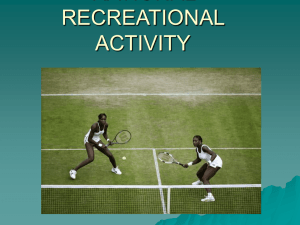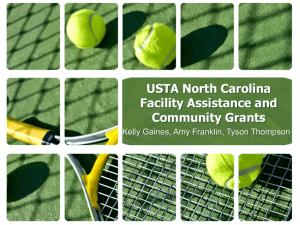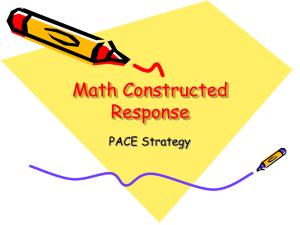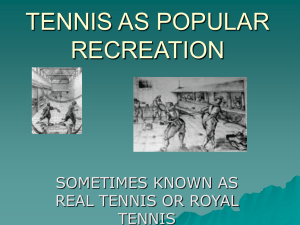PACE_Presentation_FINAL
advertisement
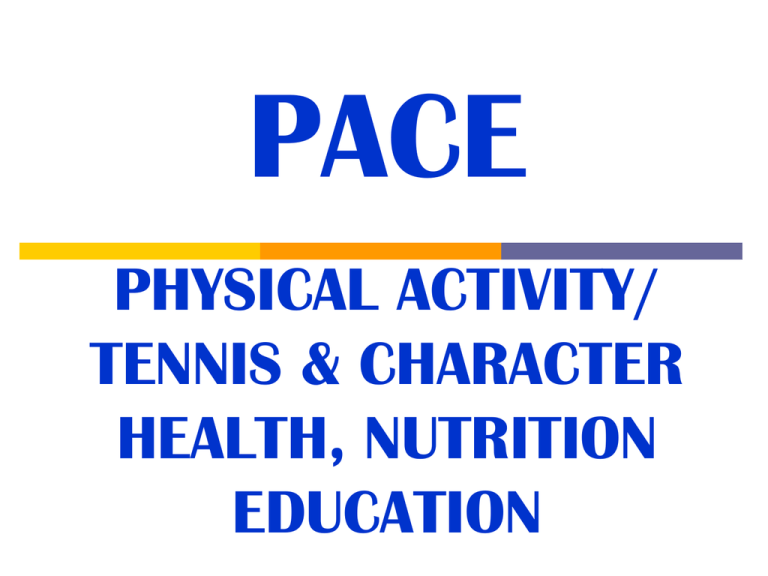
PACE PHYSICAL ACTIVITY/ TENNIS & CHARACTER HEALTH, NUTRITION EDUCATION Purpose of Presentation To share a successful university-community collaborative program How we went about funding the program Program specifics Not just for world-class athletes. Tennis is played by people all around the world! Something that was once a pastime for kings has become a sport for all! Tennis is for Everyone – ESPECIALLY for children in Akron, Ohio! Thanks to grants from Tennis Serves, Midwest Youth & Tennis Education Foundation, and The University of Akron. PACE PACE extends in-school tennis and education programming to children residing in low-income communities where obesity, constant physical inactivity, and high fat/low fiber diets tend to be more pronounced. PACE * Free, 6-weeks tennis program * In-school (not after-school) * Offered in collaboration with the physical education teachers of the Akron Public Schools * Service-learning for University of Akron students … majoring in sport/exercise science/PETE/ coaching/sport management PACE Grows the Game of Tennis Collaboration is the key • Department of Sport Science & Wellness Education; University of Akron • Akron Public School Physical Education Teachers, Principals, Administrators • University of Akron Federal Work Study Administrator (Gwen Jenkins) • First Book of Greater Akron (Chuck Bell) • Business Executives (Kropp Family) Served over 7,000 youth PRESENTERS TEACHING TENNIS Jada Ransome Senior, PETE Sport Science & Wellness Education University of Akron Akron, OH 44325 330-972-6485 CHARACTER EDUCATION Alexis Holt Graduate Assistant Sport Science & Wellness Education University of Akron Akron, OH 44325 330-972-6485 HEALTH FAIRS Ashley White Graduate Assistant Sport Science & Wellness Education University of Akron Akron, OH 44325 330-972-6485 External Evaluator Executive Director Contact Information for Mary J. MacCracken (maccrac@uakron.edu) Professor, Sport Science & Wellness Education The University of Akron Akron, OH 44325-5103 330-972-6485 Contact Information for Robert E. Stadulis (rstaduli@kent.edu) Emeritus Professor, Exercise Science & Sport Studies Kent State University Kent, OH 44242 330-672-2117 PACE VIDEO ..\..\..\..\..\..\..\Documents\Researc h\AAHPERD\Charlotte 2013\FINAL PRESENTATION\PACE.wmv 1:30 – 2:38 Miss Jada Ransome Ms. Jada Ransome Tennis lessons from USTA and adapted from the text by Bonnie Mohnsen (2008), Teaching Tennis: A StandardsBased Approach for Grades 5-8. Tennis Lessons (Skill Level Progression) Ball toss; hug racket Ready position Strike tennis ball to self – palm up/palm down Alligator catch (with partner) Wall volley to self racket “sweet spot” Bunt ball tossed by teacher, by partner Wall volley Forehand Backhand Stations Rally Games Taking Roll At the Beginning of Class Learning the “ready position” Watch spacing – not too close to others. Tap Downs and Bump Ups Practicing ball control Walking and dribbling the ball Station Work Can you bounce the ball to your partner? The goal is to keep everyone active Keep control of your racket Forehand…Keep the Racket Flat The Physical Education Teacher Helps Too Step, side to the net and watch for the ball. Children learn to stroke a tossed tennis ball. Hit the ball in the sweet spot. Learning the Forehand Stroke Outdoors Too High School Students Learned Tennis CHARACTER EDUCATION Next Presenter Character Education Alexis Holt What is character education? Umbrella term used to describe the teaching of children in a manner that will help them develop both mentally and socially Seeks to develop: Virtues Human Excellence How do we teach character? We begin by teaching the children 5 rules that are always present and expect to be followed: 1. Always Hug your racket when not in use 2. Take care of the equipment 3. Throw the ball underhand at all times 4. Don’t talk while the teacher/others are talking 5. When we ask you a question and the answer is “YES” please respond with “YES” What qualities the rules teach Hug your racket teaches: Take care of the equipment teaches: Self control Being thoughtful of others Aware of your surroundings Responsibility and appreciation Throw the ball underhand teaches: Taking direction and applying Focus and accountability What qualities are taught (cont.) Don’t talk while teacher is talking: Self control Respect When we ask you a question and the answer is “YES,” responding with “YES” teaches: Self control Take your turn Cooperate Play fair What students personally learned Stories, pictures, video from participants. Structure 1. Executive director will monitor by visiting and teaching at sites regularly 2. Evaluator will monitor programming by unannounced site visits 3. Akron Public School physical education teacher will give feedback to PACE teachers, executive director, and evaluator HEALTH and NUTRITION EDUCATION Next Presenter Health Fair Ashley White Organization 5 stations Dental Nutrition Drugs/Alcohol Hygiene Exercise Every child receives a brand new book from First Book. Each station is thirty minutes long. 5 minutes between each station for classes to rotate with the help of teachers and volunteers. All teachers receive a free professional massage. Time Area 2 Classroom Hall – (BACK) Bathrooms Dental Personal Health Hygiene CLASS 1 Infection Control CLASS 2 Area 3 Classroom (FRONT) Healthy Snacks CLASS 3 Area 4 GYM Area 5 Classroom (SIDE) Physical Measure CLASS 4 Alcohol/Substanc e Abuse UMADAOP CLASS 5 Dental CLASS 5 Healthy Snacks CLASS 2 Physical CLASS 3 Change 9:5510:25 Personal Hygiene CLASS 1 Alcohol/Substanc e Abuse CLASS 4 Dental CLASS 4 Healthy Snacks CLASS 1 Physical CLASS 2 Change 10:3011:00 Personal Hygiene CLASS 5 Alcohol/Substanc e Abuse CLASS 3 Dental CLASS 3 Healthy Snacks CLASS 5 Physical CLASS 1 Alcohol/Substanc e Abuse CLASS 2 Change 11:0511:35 Personal Hygiene CLASS 4 Dental CLASS 2 Personal Hygiene CLASS 3 Healthy Snacks CLASS 4 Physical CLASS 5 Alcohol/Substanc e Abuse CLASS 1 8:459:15 Change 9:209:50 Clean Up 11:35- Area 1 Dental Care How and why to brush – plaque, avoid caries, fluoride, sealant, brush, floss “swish and swallow” Giveaways: toothbrush, toothpaste Personal Hygiene Avoid infectious diseases Disease spreads via touch & cough; wash your hands, cover your mouth Rest, drink lots of fluidespecially water – don’t drink from another’s cup Giveaway: Purell Nutrition How and why to eat healthy Food Pyramid introduced and explained Giveaway: Healthy snack in plastic baggie Student volunteers from the Nutrition department help prepare healthy snacks. Exercise Measure child’s heart rate (HR) at rest and after a minute of strenuous activity. Children will learn their height, weight; experience strengthening flexibility exercises. Drug Abuse Discussion on what are drugs? How can they affect or harm your body? Peer Pressure JUST SAY NO! COOL KIDS SKIT Free professional neck massage Collaboration… Major Health Fair Supporters PACE EVALUATION NEXT PRESENTER Dr. Robert Stadulis, PACE External Evaluator PACE Evaluation Evaluation tools to measure: Student’s entering tennis knowledge & proficiency plus character (PRE) Progress during program (MID) End of program perceptions of program’s effectiveness (POST) Quantitative Qualitative Initial Assessments Tennis experience? Teachers note initial group skill levels and terminology use Character behavior is observed during lesson Assessment of Progress Teachers make note of whether lesson plan goals are achieved Move on to next skill/character concept based upon daily assessment Evaluator Observations (Announced?) Field Notes Feedback Questions to assess participants’ general reaction to PACE Asked Children: Did you enjoy the program? (yes, sometimes, somewhat or no) Would you participate again? (yes, sometimes, somewhat or no) Questions to assess participants’ general reaction to PACE (Cont.) Would you recommend the program to a friend? How much did you like tennis? (yes, maybe, not sure or no) (A lot, A little, Not at all) How much did you like other activities? (A lot, A little, Not at all) Snapshot of 4 Years of Evaluation Overall Mean Percentages Highlight selected statistics Did you enjoy the PACE tennis program? OVERALL 2009-2012 YES = 77.1% SOMEWHAT = 8.0 SOMETIMES = 9.3 NO = 5.5% Program responsiveness: After a lower score, the program rebounded in the next semester, e.g. 2010/11 = 69.9 Fall 2011 = 86.0 Would you participate again? OVERALL 2009-2012 YES = 70.4% SOMEWHAT = 7.5 SOMETIMES = 8.8 NO = 13.2% Program responsiveness: Similar to enjoyment, after a lower score the next program rebounded, e.g., 2010/11 = 59.9 Fall 2011 = 78.3 Would you recommend the program to a friend? OVERALL 2009-2012 YES = 61.8% NOT SURE = 9.5 MAYBE = 20.7 NO = 8.0% As with each question, less than 10% of the participants in PACE respond negatively (with a “NO”). How much did you like tennis? OVERALL 2009-2012 A LOT = 75.4% A LITTLE = 17.3% NOT AT ALL = 7.3% Very strong, positive and consistent support for the success of the program from the participant’s perspective How much did you like the other activities? OVERALL 2009-2012 A LOT = 77.5% A LITTLE = 16.5% NOT AT ALL = 6.1% Very strong, positive and consistent support for the success of the program from the participant’s perspective (range = 71.0 to 83.3) Overall Comment The end of program responses remain quite high in the 4th year of PACE (Fall 2012) ENJOY = 81.2% AGAIN = 76.7% RECOMMEND = 72.2% LIKE TENNIS = 81.7% LIKE PHYS ACT = 82.9% Measure of Program’s Success: Tennis End of Program Assessment Added in Fall 2011 Checklist What skills were learned Tennis Skills Checklist & F 2012 Hug your racket 100% Underhand toss 94.5% Ready position 96.4% Gator catch 93.1% Forehand 99.3% Backhand 78.4% Volley 96.3% F 2011, only 51.9% evidenced BH Qualitative Assessment Student letters of thanks To PACE To the USTA Read one sample letter Teacher feedback concerning Student character improvement (selfcontrol, cooperation) Improved social skills (communication, teamwork) Assessing participants’ general reaction to PACE (QUAL) Open ended Questions: What was your favorite part of the program? What did you dislike about the program? Would like to continue learning to play tennis (e.g., summer program/league, would like to purchase a racket or join a community tennis program)? Health Fair Success Assessed? End-of-Health Fair Questionnaire What do students say after the health fair? Did they learn about and enjoy: Nutrition – e.g., foods that are healthy, making snacks Physical activity – every day 30 minutes to an hour of vigorous activity Dental hygiene, Hand washing, Proper Hydration Character Counts Qualitative Responses Designed to assess how behavior has changed as a result of PACE participation Administered directly to students at conclusion of PACE – asks children specific questions about character/how character is evidenced: By being kind to them [people] (kindergarten) By showing it in words and actions (1st grader) Character Counts Qualitative Responses I treat others the way I want to be treated (2nd grader) By picking up the equipment (3rd grader) Without good character everything would be a ruckus (5th) So life will be fair and safe (3rd grader) [Character is] important because you know how to act (5th) [Character] helps you through life situations/can help you through school (5th) IF YOU THINK YOU CAN… YOU CAN! Executive Director Mary MacCracken Vision - See the “Big Picture” “Outside the Box” Communication - Learn to write grants Work with others - Seek collaborations with people in other disciplines Start Small – “Make haste slowly” “Great programs come from building/seizing opportunities” – Try to “give back” - Help others Build program infrastructure – sustainability Be Confident – Set Goals – Stay Focused PACE Summary SUMMARY Overall summary will detail results Will answer the question “How do you know PACE is a success?” Will answer “Does PACE ‘grow the game of tennis’ and/or ‘build lives through tennis’? Details of the USTA Serves proposal Overall Evaluation Summary Over 7,000 youth served Over 80% indicate they enjoyed PACE About 10% seek further tennis lessons/experiences University students volunteer for involvement in PACE PACE helps the USTA reach its goals To build lives through tennis and education To continue to be involved in tennis after PACE To increase tennis in the PE curriculum To understand what a “healthy lifestyle” means and to maintain such a lifestyle Is PACE a Success? Close to 100% attendance (few classes or students have dropped out) Letters to USTA, PACE students indicate they not only learned tennis skills but character (i.e., self control strategies, discipline, anger management) Does PACE enhance the USTA goal to “build lives through tennis and education”? UA students continue to volunteer for PACE service-learning experiences. Learning is a life-long process. Years after PACE, children will continue to seek ways to play tennis and tennisrelated activities and to maintain a healthy lifestyle. PACE has helped USTA Grow the Game. Teachers want tennis in their physical education curricula. The USTA Serves Program Grant Application Process USTA Serves Program Grant Online Application 1. Contact Information: Organization, Executive Director, Person Responsible. 2. Proposal Narrative: 5 pages include: A) Project Detail: Statement of need; explain how program coincides with philanthropic goals of USTA Serves. Identify all your collaborators. B) Evaluation: List tools measuring program's success. Give specific program goals. Tell how you objectively monitor/measure goals. How your program will demonstrate success? How your program will enhance your organization's ability to "build lives through tennis and education" after the grant period? http://www.ustaserves.com/grants_schol arships/grant_application_requirements/ 3. Program Sustainability: Reasonable plan for financial sustainability of program after conclusion of USTA Serves funding. Where additional support sought? If you have applied for funding from other sources, list amounts sought/when you expect a decision to be made on these requests. 4. Financial Information/List funding: From government: federal, state, county From United Way/Community Fund From corporate and/or foundation grants USTA Serves Program Grant Online Application (Continued) 5. Supporting Documentation: Attach Audited financials/Form 990 IRS determination letter/501(c)(3)number A description of each member of your Board of Directors Project budget description (tell how the grant monies will be used) Organization's overall annual budget 6. Support letters from school, city, state or federal elected officials and/or project collaborators. Tennis is for Everyone – ESPECIALLY for children in Akron, Ohio! Thanks to grants from Tennis Serves, Midwest Youth & Tennis Education Foundation, and The University of Akron. PACE Physical Activity/Tennis & Character/Health/Nutrition Education Thank You to Tennis Serves – Granting Arm of The United States Tennis Association! Thank you to the Midwest Youth Tennis & Education Foundation! Thank you University of Akron. What does the future hold for PACE? Expand Program By Adding Collaborations 1- summer camps 2- charter schools 3- youth groups 4- health fairs Questions?? For more information about PACE Contact Mary J. MacCracken, Ph.D. PACE Executive Director Professor, Sport Science & Wellness Education The University of Akron Akron, OH 44325-5103 330-972-6485 (maccrac@uakron.edu)
